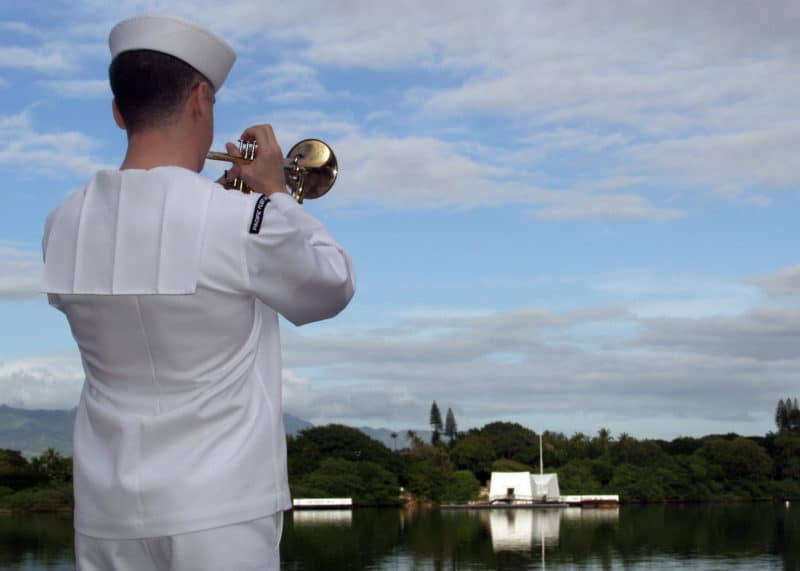On a bright, sunny Honolulu morning, December 7, 1941, as my mother hustled my brother and me out the door to Sunday school, our neighbor shouted, “Look up! Look up!” We craned our necks and saw, directly overhead, bombers and fighters with large orange circles on their wings, roaring north toward the sea. In the opposite direction, over Pearl Harbor, massive columns of black smoke were already rising into the sky, dotted with the white puffs of anti-aircraft shells. The attack had begun an hour before.
We had lived in Hawaii for less than a year. My father, Lathe Row, was a career army officer, a graduate of West Point who had ridden in the cavalry that captured Pancho Villa and had fought in the front lines in World War I. Now, nearing the end of his career, he had been appointed Inspector General of the Hawaiian Department, overseeing the Army’s small but crucial outpost closest to Japan. That morning, in a stroke of fate, he was miles away on the Big Island, inspecting the Army’s radar defenses. As soon as he could, he placed a call to my mother, telling her to be prepared to host other Army families who would be evacuated from Hickham and Wheeler airfields, destroyed in the attack. He also told her that our Japanese cook and housekeeper, Miko and Yuri, would have to be fired immediately. As they drove away, leaving the only home they’d known for decades, she sobbed.
For me, though, the weeks after Pearl Harbor were an extraordinary adventure: school was closed, and my house, on a suburban cul-de-sac in the Manoa valley, bustled with dozens of children and their mothers, whose fathers, like mine, had all but disappeared into preparations for war. Our yard and the whole neighborhood were one enormous playground; all the children, neighbors and refugees, joined together, sharing whatever toys we had. In a neighboring yard, we climbed a large monkey pod tree, whose large horizontal branches made perfect perches. There was one boy roughly my age, however, who just sat in a chair, staring into space or followed his mother everywhere. His father had been killed. My mother suggested I gently ask him out to play. He did not want to that day, but did a day or so later. He was a year younger than I was, but better at catching a ball. I wish I could remember his name.
In the evenings, after everyone had eaten and the babies and toddlers were asleep, everyone sat together on our spacious lanai, looking out on Honolulu in the twilight. The city was dark and hushed—no streetlights, no lit windows, only murky shapes under a suddenly massive sky. As the darkness lowered, the conversation turned more serious. Why had the Japanese not refueled, reloaded, and returned to destroy the remaining targets? They had left hangars, repair shops, dry docks, and fuel-tank farms relatively intact. And why did they not gather the landing craft, troop ships, and aircraft of the armada that had just invaded the Philippines, reload them with fresh troops and set off to invade Hawaii? With the Pacific Fleet largely gone we were an isolated, unprotected target.
As a senior officer, my father had access that others did not, and several times in those months he took us to see the ruins of the attack. At Pearl Harbor we saw the capsized Arizona, other ships aground or listing at odd angles, and a mini-submarine that had sneaked into the harbor in the midst of the attack, I was fascinated by the mini-submarine, imagining it was like an underwater tree house, until I realized that once in it and in an attack, the sailor had virtually no escape. Looking at the Arizona, I tried to imagine the feeling of being tossed upside down, seeing the water rush in, knowing you would drown before it happened. These images haunted me for years.
And then, so quickly, it was over: in February of 1942, with the Army still fearing a Japanese attack, we were sent back to the mainland with the other military families on a converted passenger ship. Together with my mother and brother I traveled the three days by train from San Francisco to the Black Hills of South Dakota, where her family had settled during the days of the Gold Rush. My father returned home only in 1947, after he had submitted a damning report on the attack to Congress and retired from the Army. I was in the seventh grade, and he was sixty: no longer the trim, erect, heroic officer of my childhood imagination, but a weary, tired old man. For the rest of my childhood, until I left for good on another train, heading east to Yale, we said very little to each other: a civil, but never intimate, relationship. Pearl Harbor had cost me a father in all but name, and I was one of the lucky ones.

